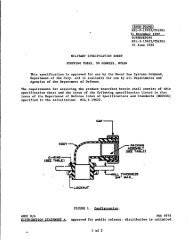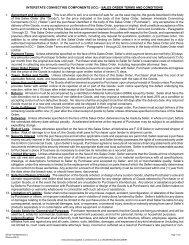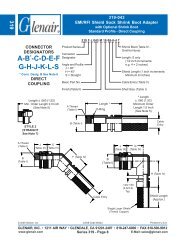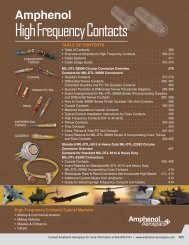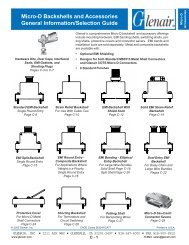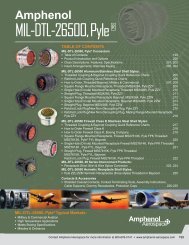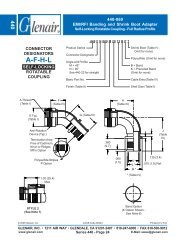Tooling Guide for Aerospace Wiring Systems - Interstate Connecting ...
Tooling Guide for Aerospace Wiring Systems - Interstate Connecting ...
Tooling Guide for Aerospace Wiring Systems - Interstate Connecting ...
Create successful ePaper yourself
Turn your PDF publications into a flip-book with our unique Google optimized e-Paper software.
Important Facts<br />
About Crimping<br />
Time Line <strong>for</strong> Crimp<br />
Technology<br />
1940s All terminations were soldered<br />
(Hard-wired)<br />
1953 AMP introduced Crimp<br />
Barrel Terminals<br />
1957 Cannon Brothers experimented<br />
with Machined Contacts with<br />
Crimp Barrels<br />
1960 Buchanan introduced the<br />
4 Indent Crimp Tool with a<br />
Ratchet (Ref: MS3191)<br />
1963 MS3191-1 was published as the<br />
first Crimp Tool Standard.<br />
1965 MS3191-4 introduced by<br />
Daniels Manufacturing Corp.<br />
1969 MIL-T-22520 published<br />
and dated to replace all<br />
previous specifications<br />
1974 Changed to MIL-C-22520,<br />
and many Slash Sheets added<br />
1996 Changed to MIL-DTL-22520<br />
2010 Changed to AS22520<br />
CRIMPING: THEN AND NOW<br />
The first multi-pin connectors were<br />
terminated by soldering the conductor to<br />
non-removable contacts. However, high<br />
temperature applications and the need <strong>for</strong><br />
simple and reliable field service led to the<br />
introduction of connectors with removable<br />
contacts. These were crimped onto the<br />
conductor rather than being soldered.<br />
The first standard crimp tool developed<br />
to crimp these new contacts was introduced<br />
in the early sixties. MS3191-1,<br />
a military drawing, defined this tool and<br />
its accessories. The MS3191-1 utilized<br />
a four indent crimp pattern together with<br />
a positive stop locator which controlled<br />
the travel of the indenters (crimp depth).<br />
The MS3191-1 design was a compromise<br />
between simplicity of operation and<br />
crimp per<strong>for</strong>mance since the crimp depth<br />
<strong>for</strong> any given contact was not adjustable<br />
to accommodate the differing diameters<br />
of the conductors to which it would be<br />
crimped. It was, however, suitable <strong>for</strong> the<br />
crimp connectors of that era.<br />
An improved tool design featuring<br />
independently adjustable crimp depths<br />
was soon introduced as MS3191-4. The<br />
MS3191-4 had an internal adjustment,<br />
totally independent of the locator, which<br />
permitted the selection of seven separate<br />
crimp depths, allowing optimal crimping<br />
of conductors ranging from AWG 12 to<br />
26 regardless of the wire barrel size of<br />
the contact.<br />
MS3191-4 also introduced the use of<br />
the double tipped indenter to produce<br />
an eight indent crimp pattern which has<br />
consistently achieved superior tensile pull<br />
off values.<br />
MS3191-4 introduced the concept of<br />
a turret head containing three locators<br />
which could be used without separating<br />
any of them from the basic crimp tool.<br />
In 1969 two military specifications <strong>for</strong><br />
crimp tools were developed to replace<br />
the existing military drawings. They were<br />
MIL-T-22520C (Navy) and MIL-T-83724<br />
(USAF) which defined a standard size<br />
crimp tool similar to the MS3191-4, but<br />
with an expanded eight step crimp depth<br />
range. These specifications also defined a<br />
miniature crimp tool to crimp conductors<br />
as small as AWG 32.<br />
Both documents were combined in<br />
1971 into MIL-C-22520D. All previous<br />
military standards <strong>for</strong> crimp tools were<br />
then cancelled including the MS3191.<br />
This list includes specifications <strong>for</strong> indent<br />
crimp tools, terminal lug crimp tools,<br />
pneumatic tools, coaxial cable crimp tools<br />
and connector service kits.<br />
MIL-DTL-22520 established a single<br />
specification which set <strong>for</strong>th per<strong>for</strong>mance<br />
requirements <strong>for</strong> all crimp tools to be used<br />
on military standard electrical connectors.<br />
This eliminated the waste and confusion<br />
which accompanied the overlapping applications<br />
of many different “standard” crimp<br />
tools called out by a deluge of unrelated<br />
military drawings.<br />
THE CRIMPING CONCEPT<br />
Crimping is a method of firmly<br />
attaching a terminal or contact end to an<br />
electrical conductor by pressure <strong>for</strong>ming<br />
or reshaping a metal barrel together<br />
with the conductor. The <strong>for</strong>ming of a<br />
satisfactory crimp depends on the correct<br />
combination of conductor, crimp barrel<br />
and tool.<br />
When applied with a properly matched<br />
tool, a union is established which has<br />
both good electrical and mechanical<br />
characteristics. The tool will provide these<br />
requirements consistently and reliably<br />
with repeatability assured by quality cycle<br />
controlled tooling. There are several<br />
common configurations of crimped joint;<br />
several examples are shown below.<br />
The electrical resistance of a properly<br />
designed and controlled crimped joint<br />
should be equal to, or less than, the<br />
resistance of an equal section of wire.<br />
Specifications state the requirements<br />
in terms of millivolt drop at a designated<br />
current.<br />
The mechanical strength of a crimped<br />
joint and hence its pull-out <strong>for</strong>ce (tensile<br />
strength), varies with the de<strong>for</strong>mation<br />
applied. There<strong>for</strong>e, by properly shaping<br />
the de<strong>for</strong>mation a high pull-out <strong>for</strong>ce can<br />
be achieved, i.e. the crimp die of the tool<br />
determines the crimp configuration and<br />
de<strong>for</strong>mation.<br />
The dies in the tool determine the<br />
completed crimp configuration which<br />
is generally an element of contact and/<br />
or connector design. Some of the design<br />
considerations are: a) The type of contact,<br />
its size, shape, material and function,<br />
b) The type and size of wires to be<br />
accommodated, c) The type of tooling<br />
into which the configuration must be built.<br />
Eight Indent<br />
Four Indent<br />
Two Indent<br />
Hexagonal Crimp<br />
Circular Crimp<br />
B Crimp<br />
Nest & Indent Crimp<br />
Captive Crimp<br />
Insulation Displacement<br />
© Copyright 2010 Daniels Manufacturing Corp. ALL RIGHTS RESERVED. www.DMCTools.com<br />
PAGE 1



